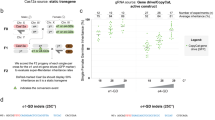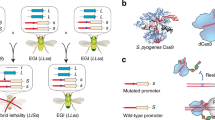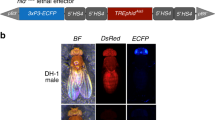Abstract
The recent establishment of broadly applicable genetic transformation systems will allow the analysis of gene function in diverse insect species. This will increase our understanding of developmental and evolutionary biology. Furthermore, insect transgenesis will provide new strategies for insect pest management and methods to impair the transmission of pathogens by human disease vectors. However, these powerful techniques must be applied with great care to avoid harm to our environment.
This is a preview of subscription content, access via your institution
Access options
Subscribe to this journal
Receive 12 print issues and online access
$189.00 per year
only $15.75 per issue
Buy this article
- Purchase on Springer Link
- Instant access to full article PDF
Prices may be subject to local taxes which are calculated during checkout


Similar content being viewed by others
References
Rubin, G. M. & Spradling, A. C. Genetic transformation of Drosophila with transposable element vectors. Science 218, 348–353 (1982).
O'Brochta, D. A. & Atkinson, P. W. Building the better bug. Sci. Am. 279, 90–95 (1998).
Handler, A. M., Gomez, S. P. & O'Brochta, D. A. A functional analysis of the P-element gene–transfer vector in insects. Arch. Insect Biochem. Physiol. 22, 373–384 (1993).
Rio, D. C. & Rubin, G. M. Identification and purification of a Drosophila protein that binds to the terminal 31-base-pair inverted repeats of the P transposable element. Proc. Natl Acad. Sci. USA 85, 8929–8933 (1988).
Berghammer, A. J., Klingler, M. & Wimmer, E. A. A universal marker for transgenic insects. Nature 402, 370–371 (1999).
Horn, C., Jaunich, B. & Wimmer, E. A. Highly sensitive, fluorescent transformation marker for Drosophila transgenesis. Dev. Genes Evol. 210, 623–629 (2000).
Hediger, M., Niessen, N., Wimmer, E. A., Dübendorfer, A. & Bopp, D. Germline transformation of the housefly Musca domestica with the lepidopteran derived transposon piggyBac. Insect Mol. Biol. 10, 113–119 (2001).
Kokoza, V., Ahmed, A., Wimmer, E. A. & Raikhel, A. S. Efficient transformation of the yellow fever mosquito Aedes aegypti using the piggyBac transposable element vector pBac[3×P3–EGFPafm]. Insect Biochem. Mol. Biol. 31, 1137–1143 (2001).
Ito, J., Ghosh, A., Moreira, L. A., Wimmer, E. A. & Jacobs-Lorena, M. Transgenic anopheline mosquitoes impaired in transmission of a malaria parasite. Nature 417, 452–455 (2002).
Thomas, J. -L., Da Rocha, M., Besse, A., Mauchamp, B. & Chavancy, G. 3×P3EGFP marker as a powerful tool to facilitate the screening of the transgenic Bombyx mori L. Insect Biochem. Mol. Biol. 32, 247–253 (2002).
Uhlír×ova, M., Asahina, M., Riddiford, L. M. & Jindra, M. Inducible transgenic expression of the Ftz-F1 nuclear receptor in the silkmoth Bombyx mori. Dev. Genes Evol. 212, 145–151 (2002).
Handler, A. M. & James, A. A. Insect Transgenesis: Methods and Applications (CRC, Boca Raton, Florida, 2000).
Atkinson, P. W., Pinkerton, A. C. & O'Brochta, D. A. Genetic transformation systems in insects. Annu. Rev. Entomol. 46, 317–346 (2001).
Handler, A. M. A current perspective on insect gene transformation. Insect Biochem. Mol. Biol. 31, 111–128 (2001).
Atkinson, P. W. & James, A. A. Germline transformants spreading out to many insect species. Adv. Genet. 47, 49–86 (2002).
Horn, C., Schmid, B. G. M., Pogoda, F. S. & Wimmer, E. A. Fluorescent transformation markers for insect transgenesis. Insect Biochem. Mol. Biol. 32, 1221–1235 (2002).
Halfon, M. S., Kose, H., Chiba, A. & Keshishian, H. Targeted gene expression without a tissue-specific promoter: creating mosaic embryos using laser-induced single-cell heat-shock. Proc. Natl Acad. Sci. USA 94, 6255–6260 (1997).
Horn, C. & Wimmer, E. A. A versatile vector set for animal transgenesis. Dev. Genes Evol. 210, 630–637 (2000).
Hannon, G. J. RNA interference. Nature 418, 244–251 (2002).
Bucher, G., Scholten, J. & Klingler, M. Parental RNAi in Tribolium (Coleoptera). Curr. Biol. 12, R85–R86 (2002).
Kennerdell, J. R. & Carthew, R. W. Heritable gene silencing in Drosophila using double-stranded RNA. Nature Biotechnol. 18, 896–898 (2000).
Hughes, C. L. & Kaufman, T. C. A diverse approach to arthropod development. Evol. Dev. 2, 6–8 (2000).
Cooley, L., Kelley, R. & Spradling, A. Insertional mutagenesis of the Drosophila genome with single P elements. Science 239, 1121–1128 (1988).
O'Kane, C. J. & Gehring W. J. Detection in situ of genomic regulatory elements in Drosophila. Proc. Natl Acad. Sci. USA 84, 9123–9127 (1987).
Horn, C., Offen, N., Nystedt, S., Häcker, U. & Wimmer, E. A. piggyBac-based insertional mutagenesis and enhancer detection as a tool for functional insect genomics. Genetics 163 (in the press).
Raff R. A. The Shape of Life (The Univ. of Chicago Press, Chicago, Illinois, 1996).
Garstang W. The theory of recapitulation: a critical restatement of the biogenetic law. Zool. J. Linn. Soc. 35, 81–101 (1922).
Jacob, F. Evolution and tinkering. Science 196, 1161–1166 (1977).
Duboule, D. & Wilkins, A. S. The evolution of “bricolage”. Trends Genet. 14, 54–59 (1998).
Tautz, D. Evolution of transcriptional regulation. Curr. Opin. Genet. Dev. 10, 575–579 (2000).
Ludwig, M. Z., Patel, N. H. & Kreitman, M. Functional analysis of eve stripe 2 enhancer evolution in Drosophila: rules governing conservation and change. Development 125, 949–958 (1998).
Ludwig, M. Z., Bergman, C., Patel, N. H. & Kreitman, M. Evidence for stabilizing selection in a eukaryotic enhancer element. Nature 403, 564–567 (2000).
Wolff, C., Schröder, R., Schulz, C., Tautz, D. & Klingler, M. Regulation of the Tribolium homologues of caudal and hunchback in Drosophila: evidence for maternal gradient systems in a short germ embryo. Development 125, 3645–3654 (1998).
Rivera-Pomar, R. & Jäckle, H. From gradients to stripes in Drosophila embryogenesis: filling in the gaps. Trends. Genet. 12, 478–483 (1996).
Sander, K. Specification of the basic body pattern in insect embryogenesis. Adv. Insect Physiol. 12, 125–238 (1976).
Adams, M. D. et al. The genome sequence of Drosophila melanogaster. Science 287, 2185–2195 (2000).
Holt, R. A. et al. The genome sequence of the malaria mosquito Anopheles gambiae. Science 298, 129–149 (2002).
Tomita M. et al. Transgenic silkworms produce recombinant human type III procollagen in cocoons. Nature Biotechnol. 21, 52–56 (2003).
Hoy, M. A. Insect Molecular Genetics (Academic Press, San Diego, California, 1994).
Krafsur, E. S. Sterile insect technique for suppressing and eradicating insect population: 55 years and counting. J. Agric. Entomol. 15, 303–317 (1998).
Hendrichs, J., Franz, G. & Rendon, P. Increased effectiveness and applicability of the sterile insect technique through male-only releases for control of Mediterranean fruit flies during fruiting seasons. J. Appl. Entomol. 119, 371–377 (1995).
Robinson, A. S. & Franz, G. in Insect Transgenesis: Methods and Applications (eds Handler, A. M. & James, A. A.) 307–318 (CRC, Boca Raton, Florida, 2000).
Hagler, J. R. & Jackson, C. G. Methods for marking insects: current techniques and future prospects. Annu. Rev. Entomol. 46, 511–543 (2001).
Peloquin, J. J., Thibault, S. T., Staten, R. & Miller, T. A. germline transformation of pink bollworm (Lepidoptera: gelechiidae) mediated by the piggyBac transposable element. Insect Mol. Biol. 9, 323–333 (2000).
Handler, A. M. & Harrell, R. A. Polyubiquitin-regulated DsRed marker for transgenic insects. Biotechniques 31, 820, 824–828 (2001).
Heinrich, J. C. & Scott, M. J. A repressible female-specific lethal genetic system for making transgenic insect strains suitable for a sterile-release program. Proc. Natl Acad. Sci. USA 97, 8229–8232 (2000).
Thomas, D. D., Donnelly, C. A., Wood, R. J. & Alphey, L. S. Insect population control using a dominant, repressible, lethal genetic system. Science 287, 2474–2476 (2000).
Horn, C. & Wimmer, E. A. A transgene-based embryo-specific lethality system for insect pest mangement. Nature Biotechnol. 21, 64–70 (2003).
Higgs, S. et al. Engineered resistance in Aedes aegypti to a West African and a South American strain of yellow fever virus. Am. J. Trop. Med. Hyg. 58, 663–670 (1998).
Olson, K. E. et al. Genetically engineered resistance to dengue-2 virus transmission in mosquitoes. Science 272, 884–886 (1996).
Adelman, Z. N., Blair, C. D., Carlson, J. O., Beaty, B. J. & Olson, K. E. Sindbis virus-induced silencing of dengue viruses in mosquitoes. Insect Mol. Biol. 10, 265–273 (2001).
Olson, K. E. et al. Developing arbovirus resistance in mosquitoes. Insect Biochem. Mol. Biol. 32, 1333–1343 (2002).
Ribeiro, J. M. & Kidwell, M. G. Transposable elements as population drive mechanisms: specification of critical parameter values. J. Med. Entomol. 31, 10–16 (1994).
Lycett, G. J. & Kafatos, F. C. Anti-malarial mosquitoes? Nature 417, 387–388 (2002).
National Research Council. Animal Biotechnology: Science-based Concerns (The National Academic Press, Washington, District of Columbia, 2002).
Atkinson, P. W. Genetic engineering in insects of agricultural importance. Insect Biochem. Mol. Biol. 32, 1237–1242 (2002).
Gehring, W. J. The genetic control of eye development and its implications for the evolution of the various eye-types. Int. J. Dev. Biol. 46, 65–73 (2002).
Ghosh, A. K., Moreira, L. A. & Jacobs-Lorena, M. Plasmodium–mosquito interactions, phage display libraries and transgenic mosquitoes impaired for malaria transmission. Insect Biochem. Mol. Biol. 32, 1325–1331 (2002).
Ghosh, A. K., Ribolla, P. E & Jacobs-Lorena, M. Targeting Plasmodium ligands on mosquito salivary glands and midgut with a phage display peptide library. Proc. Natl Acad. Sci. USA 98, 13278–13281 (2001).
Moreira, L. A. et al. Robust gut–specific gene expression in transgenic Aedes aegypti mosquitoes. Proc. Natl Acad. Sci. USA 97, 10895–10898 (2000).
Moreira, L. A. et al. Bee venom phospholipase inhibits malaria parasite development in transgenic mosquitoes. J. Biol. Chem. 277, 40839–40843 (2002).
Wirth, D. F. Biological revelations. Nature 419, 495–496 (2002).
Duffy, J. B. GAL4 system in Drosophila: a fly geneticist's Swiss army knife. Genesis 34, 1–15 (2002).
Szüts, D. & Bienz, M. LexA chimeras reveal the function of Drosophila Fos as a context-dependent transcriptional activator. Proc. Natl Acad. Sci. USA 97, 5351–5356 (2000).
Bello, B., Resendez-Perez, D. & Gehring, W. J. Spatial and temporal targeting of gene expression in Drosophila by means of a tetracycline-dependent transactivator system. Development 125, 2193–2202 (1998).
Lewandoski, M. Conditional control of gene expression in the mouse. Nature Rev. Genet. 2, 743–755 (2001).
Acknowledgements
I am grateful to B. Jaunich and F. Pogoda for technical assistance and wish to thank V. Kokoza, J.-L. Thomas and M. Jindra for providing photographs. I apologize to all the authors whose important work I did not cite owing to the strict space restrictions of this article. Work in my laboratory is supported by the European Molecular Biology Organization Young Investigator Programme, the Deutsche Forschungsgemeinschaft, the Fonds der Chemischen Industrie, the Bundesministerium für Bildung und Forschung and especially by the Robert Bosch Foundation who provided an independent junior research group.
Author information
Authors and Affiliations
Related links
Related links
DATABASES
LocusLink
FURTHER INFORMATION
Berkeley Drosophila Genome Project
Drosophila Genome Project at the Human Genome Sequencing Center at Baylor College of Medicine
Genome News Network — moth DNA sequenced
International Lepidopteran Genome Project
Glossary
- BALANCER CHROMOSOMES
-
Chromosomes that contain inversions and visible markers. Balancer chromosomes facilitate crossing schemes by suppressing recombination between homologues and by being easily detected.
- BLASTODERM
-
The layer of cells that completely surrounds an internal mass of yolk in an insect embryo.
- CASTE FORMATION
-
The development of different groups of individuals of predictable morphological types or behaviour that have specialized tasks in a colony of social insects.
- DIAPAUSE
-
A resting phase in the life cycle of an organism. It is a period of suspended growth or development, characterized by greatly reduced metabolic activity.
- GERM PLASM
-
Cytoplasm that is localized to a certain region within the insect oocyte that is necessary for the correct development of germ cells.
- HAEMOCOEL
-
The large body cavity of insects in which haemolymph (insect blood) flows.
- HORIZONTAL GENE TRANSFER
-
The transfer of genetic material between the genomes of two organisms, which usually belong to different species.
- MACROEVOLUTIONARY EVENT
-
Evolution that occurs above the species level and over protracted periods of geological time (for example, speciation, morphological change and extinction).
- MICROEVOLUTIONARY EVENT
-
A minor evolutionary event that is usually observed over a short period of time. It consists of changes in gene frequencies, chromosome structure or number in a population over a few generations.
- NAIVE MICE
-
Mice that have not been exposed to a particular pathogen or parasite.
- NON-AUTONOMOUS
-
A non-autonomous transposon is not able to transpose by itself, but will transpose if transposase activity is provided by an independent source.
- ONTOGENY
-
The course of development and growth of an individual from egg to maturity.
- ORTHOLOGUES
-
Homologous genes in different species, the lineage of which derives from a common ancestral gene without gene duplication or horizontal transmission.
- PAIR-RULE GENES
-
Genes expressed as transverse stripes in alternate segment equivalents of a developing insect embryo.
- PHAGE DISPLAY LIBRARY
-
A heterogeneous mixture of recombinant phage clones, each carrying a different foreign DNA insert and, therefore, displaying a different peptide on their surface.
- PHENOCOPY
-
An experimentally or environmentally induced phenotypic variation that resembles the effect of a known gene mutation.
- PHYLOGENY
-
The evolutionary history of a group or lineage.
- RNA INTERFERENCE
-
(RNAi). A process by which double-stranded RNA silences specifically the expression of homologous genes through degradation of their cognate mRNA.
- STABILIZING SELECTION
-
Selection for the mean or intermediate phenotype. Consequently, peripheral variants are eliminated, maintaining an existing state of adaptation in a stable environment.
- STRIPE ELEMENT
-
A cis-regulatory DNA sequence that acts as an enhancer of gene expression and mediates regionally restricted expression of zygotic developmental genes in transverse stripes.
Rights and permissions
About this article
Cite this article
Wimmer, E. Applications of insect transgenesis. Nat Rev Genet 4, 225–232 (2003). https://doi.org/10.1038/nrg1021
Issue Date:
DOI: https://doi.org/10.1038/nrg1021
This article is cited by
-
Identification of genes for engineering the male germline of Aedes aegypti and Ceratitis capitata
BMC Genomics (2016)
-
Construction of transformed, cultured silkworm cells and transgenic silkworm using the site-specific integrase system from phage φC31
Molecular Biology Reports (2014)
-
Three Heat Shock Protein Genes from Bactrocera (Tetradacus) minax Enderlein: Gene Cloning, Characterization, and Association with Diapause
Neotropical Entomology (2014)
-
Optimal barrier zones for stopping the invasion of Aedes aegypti mosquitoes via transgenic or sterile insect techniques
Theoretical Ecology (2013)
-
A visible dominant marker for insect transgenesis
Nature Communications (2012)



